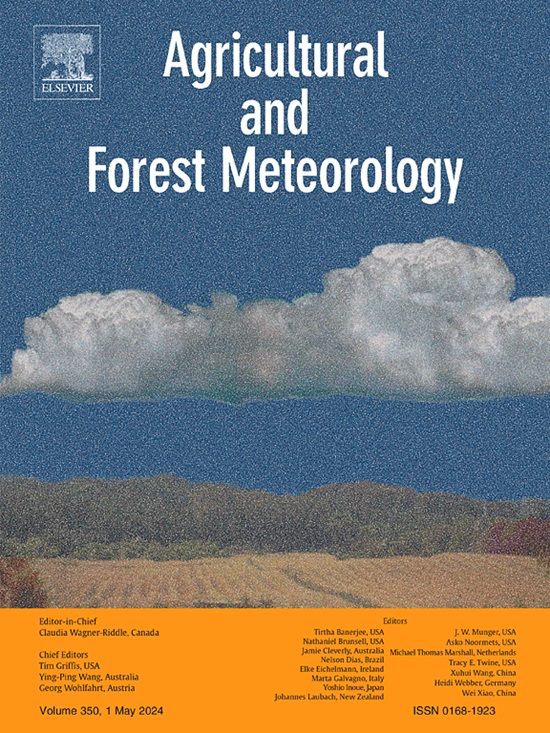碳动态、排放减缓和农田产量优化:用于多变量预测的机器学习框架
IF 5.7
1区 农林科学
Q1 AGRONOMY
引用次数: 0
摘要
机器学习(ML)已成为农业生态系统应用中一种很有前途的方法,用于模拟不同施肥管理实践(FMP)及其对作物产量、土壤有机碳(SOC)浓度和温室气体(GHG)排放的影响。然而,现有的基于机器学习的研究往往侧重于预测单变量,缺乏系统的框架,限制了模型的可靠性和实际应用。本研究通过提出基于机器学习的农业生态系统多变量预测的系统模块化框架来解决这些差距。利用全面的田间实测数据,我们开发了一个多变量系统来预测中国三种主要作物的作物产量、有机碳积累和温室气体排放(N₂O, CH₄)。本研究评估了一系列关于模型性能的预处理技术和算法,并展示了该模型在华北平原(NCP)的应用,以确定平衡生产力与碳减排的fmp。结果表明,k-Nearest Neighbors missing data imputation、Local Outlier Factor Outlier detection和Random Forest ML算法相结合,在产率(R²= 0.83)、SOC (R²= 0.91)和N₂O排放量(R²= 0.83)方面表现最佳。这些模型在所有环境、土壤和管理子组中都优于其他候选模型。值得注意的是,与传统做法相比,使用测量变量评估具有相似精度的模型在预测fmp效果时可以显示出实质性的变异性,这突出了稳健模型选择对于优化fmp提供可靠指导的重要性。部分依赖图(PDP)分析揭示了有机碳积累的不同阶段,强调需要具有广泛时间覆盖的输入数据集来捕捉有机碳动态的短期动态和长期趋势。总体而言,在整个案例研究区域,我们发现50%的粪肥氮替代可以使玉米和小麦的全球变暖潜势分别降低29.5%和19.5%,同时在30年内使有机碳浓度增加5倍以上。本文章由计算机程序翻译,如有差异,请以英文原文为准。
Carbon dynamics, emission mitigation, and yield optimization in farmlands: A machine learning framework for multi-variable prediction
Machine learning (ML) has become a promising approach in agro-ecosystem applications to simulate different fertilization management practices (FMP) and their impact on crop yield, soil organic carbon (SOC) concentration, and greenhouse gas (GHG) emissions. However, existing ML-based studies often focus on predicting single variables and lack a systematic framework, limiting model reliability and practical application. This study addresses these gaps by proposing a systematic, modular framework for ML-based multi-variable prediction in agro-ecosystems. Utilizing a comprehensive field-measured dataset, we developed a multi-variable system to predict crop yield, SOC accumulation, and GHG emissions (N₂O, CH₄) for three staple crops in China. The study evaluates a range of preprocessing techniques and algorithms on model performance and demonstrates the model’s application in the North China Plain (NCP) to identify FMPs that balance productivity with carbon mitigation. Our results show that k-Nearest Neighbors missing data imputation, Local Outlier Factor outlier detection, and the Random Forest ML algorithm combined to deliver the best performance for yield (R² = 0.83), SOC (R² = 0.91), and N₂O emissions (R² = 0.83). These models outperformed other candidates across all environmental, soil, and management subgroups. Notably, models with similar accuracy when evaluated with measured variables can show substantial variability in predicting the effects of FMPs compared to conventional practices, highlighting the importance of robust model selection for providing reliable guidance in optimizing FMPs. Partial Dependence Plot (PDP) analysis revealed distinct phases in SOC accumulation, underscoring the need for input datasets with broad temporal coverage to capture both short-term dynamics and long-term trends in SOC dynamics. Overall across the case study area, we identify that 50% Manure-N substitution can reduce global warming potential by 29.5% for maize and 19.5% for wheat while increasing SOC concentration more than fivefold over 30 years.
求助全文
通过发布文献求助,成功后即可免费获取论文全文。
去求助
来源期刊
CiteScore
10.30
自引率
9.70%
发文量
415
审稿时长
69 days
期刊介绍:
Agricultural and Forest Meteorology is an international journal for the publication of original articles and reviews on the inter-relationship between meteorology, agriculture, forestry, and natural ecosystems. Emphasis is on basic and applied scientific research relevant to practical problems in the field of plant and soil sciences, ecology and biogeochemistry as affected by weather as well as climate variability and change. Theoretical models should be tested against experimental data. Articles must appeal to an international audience. Special issues devoted to single topics are also published.
Typical topics include canopy micrometeorology (e.g. canopy radiation transfer, turbulence near the ground, evapotranspiration, energy balance, fluxes of trace gases), micrometeorological instrumentation (e.g., sensors for trace gases, flux measurement instruments, radiation measurement techniques), aerobiology (e.g. the dispersion of pollen, spores, insects and pesticides), biometeorology (e.g. the effect of weather and climate on plant distribution, crop yield, water-use efficiency, and plant phenology), forest-fire/weather interactions, and feedbacks from vegetation to weather and the climate system.

 求助内容:
求助内容: 应助结果提醒方式:
应助结果提醒方式:


